Now, the use of tactile tiles is spreading throughout the world. Low-profile directional tactile markings are installed on busy pedestrian crossings in Japan. Blocks are yellow, silver, black, grey, green and brown. Lozenge paving is used as a platform edge warning for on-street applications. Tactile ground surface indicators are frequently installed across the entire sloped area leading to a crosswalk, creating an obstacle for wheelchair users and others. No blocks are installed outside this area, however. They are readily available in pre-cast concrete, in a range of colours as clay pavers, and in natural stone by special order. Most directional blocks are white or grey, while warning blocks are yellow or grey.
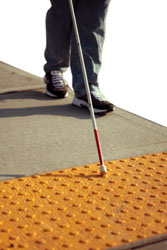
There are, however, no installations of tactile ground surface indicators.[10]. For the concrete flag versions of the blister paving, the red, buff and 'Natural' grey are the three usual colours. Inspired by a few, clear design principles (universality of signs, safety, durability), the system allows endless applications in both exterior and interior. not less than 65% for a diameter 251 on the raised section for composite-construction (made of two materials that are different colours) tactile indicators. In 2015, the Government of India has launched the Accessible India Campaign to make the nation's infrastructure more inclusive and accessible. Blocks are yellow, silver, blue, green and grey. Ever wondered what those different bumps and lumps on the pavement mean? Henshaws rely on voluntary donations; our work just wouldnt be possible without people like you. In many towns and cities where cycle lanes are delineated by means of a kerb or similar, the bicycle-only lanes are now being identified by using a red or green surface dressing or bitmac to give a strong visual indicator.
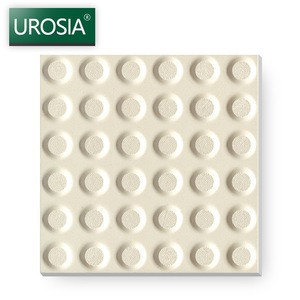
The cycle way tactile comprises a series of continuous raised, flat-topped bars, each 50.5mm high, 30mm wide and spaced 70mm apart. By definition if it blends in more, its harder for partially sighted people or obviously in a more dire situations, people could find themselves in the road, not knowing theyre in the road..

Its modern form can be classified into two types: one has small, round bumps upon the surface of the block, which are felt through a sole (known as warning block), and the second is a directional aid, with long, slender bumps being installed on the surface (known as directional block). 2014-2022 Royal National Institute of Blind People, s in a grid mean a dropped curb for crossing the road, r example, bright contrasting colours help partially sighted people to understand if theyre at a traffic lights crossing. Tijuana uses landmark installations before crosswalks that are similar to those used in California.
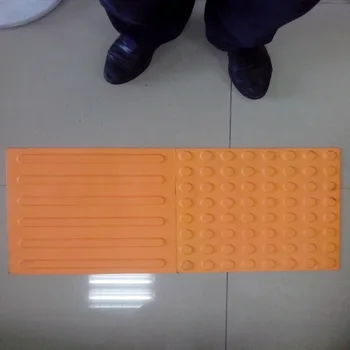
Blocks are yellow, silver, brown, white and grey. The surface is an essential safety feature and consists of rows of flat topped blisters in a square pattern. They should never be installed closer to the edge than that, because pedestrians may not have sufficient time to stop walking once they have detected the tactile warning surface.[4]. The tactile surface should be used on any segregated shared route where the pedestrian side is not physically separated from the cyclist side. They are also required along the edges of boarding platforms in transit facilities and the perimeter of reflecting pools. In one part of the city, metal bars are embedded in the road surface where warning blocks would be expectedat the top of stairs and escalators, for example. Lozenges mean that theres a tram crossing, Horizontal stripes? Bangkok is a city with many vendors who set up their shops on sidewalks, which frequently cover the blocks. They can also be found winding through suburban areas surrounding major cities; the volume of blocks installed is second only to Japan. [10] In addition, Pulau Tikus and Brickfields have installed tactile paving to helping vision-impaired people get to surrounding places. Your support empowers local people living with sight loss and a range of other disabilities to increase their independence, achieve their dreams, and go beyond expectations. The purpose of the blister surface is to provide a warning to vision-impaired people who would otherwise, in the absence of a change of height of >25mm, find it difficult differentiate between where the footway ends and the carriageway begins.

It is also used where a footway joins a shared route. In some locations, warning and directional blocks are installed as in Japan, while in other locations, directional indicators are carved into the pavement and warning blocks are installed where directional markers intersect and where pedestrians are to stop. More information Accept. Some larger cities, such as Leipzig have installed tactile paving throughout their city centers, including normal signs requesting that the paving be kept free of obstacles. [18] Schools, hospitals, theatres, arenas, community centres, exhibition halls, department stores, hotels, office, multidwelling units, or senior homes with floor space less than 2,000m2 (22,000sqft), must spend reasonable effort to install and maintain tactile pavings inside the building, but it is not required. Arguments have been made that the money spent on installing tactile pavement could have been much better spent making other improvements that vision-impaired people have actually requested, such as faster repairs to broken pavement,[7] and that more thought should have been put into balancing the needs of vision-impaired pedestrians and mobility-impaired pedestrians, such as wheelchair and cane users, who can trip on the bumps.[8]. [10], In the metropolitan cities of Mumbai and Delhi, warning and directional blocks, resembling those in Japan, have been installed in sidewalks leading to and inside metro stations. The purpose of the guidance path surface is to guide vision-impaired people along a route when the traditional cues, such as a property line or kerb edge, are not available. Disability Unit - Circular 1/91 on the use of dropped kerbs and tactile surfaces. The bars are 60.5mm high, 20mm wide, and spaced 50mm from the centre of one bar to the centre of the next. The corduroy tactile can be used for any situation (other than pedestrian crossings) where vision-impaired individuals need to be warned of a hazard, such as: The purpose of the tactile surface used in conjunction with a segregated shared cycle track and footpath is to advise vision-impaired people of the correct side to enter. Delhi Metro, which has the most accessible public transport infrastructure in the country, has tactile paving from entry to exit.
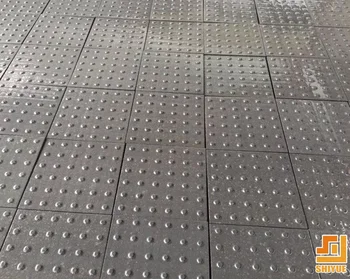
That has led to the standardisation of the system throughout Japan. The tiles are yellow. The off-set blister tactile surface consists of flat-topped domes (blisters), spaced 66.5mm apart from the center of one dome to the next one. have a top surface that does not protrude more than 4-5mm above the substrate. [17] Tactile pavers are installed at almost all curb ramps in Japan.
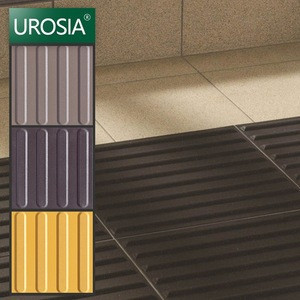
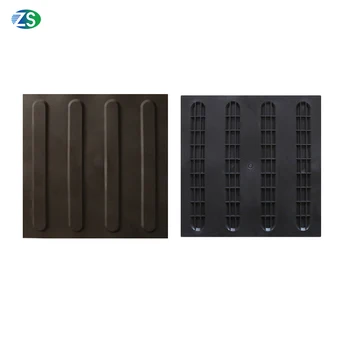
[10], Blocks with bars are also used to mark cycle tracks, but with the bars parallel to the direction of travel. Blue blocks are frequently used at rail stations while yellow is often used at light rail stations.[10]. Rubber warning blocks are also sometimes installed at bus stops where directional blocks intersect. It is intended to be used as a hazard warning, most notably for flights of steps. Both warning blocks and directional blocks are installed according to the same rules as in Japan. With the expansion of tram networks along with on-going redevelopment of bus stops to make them more disabled-friendly, this type of paving is becoming more common. Richard Holmes voices his thoughts on the issue as a partially sighted person: "Boroughs in London, councils outside of London, seem to be moving towards aesthetic considerations. The surface is usually buff coloured, but can be any colour, other than red, that provides a good contrast with the surrounding area to assist partially sighted people. This page provides an overview of the various types in use. Interestingly, one enquirer asked whether the thermoplastic Rumble Strips, used at the edge of major carriageways and motorways to alert vehicles they are straying onto the hard shoulder, could be considered to be Tactile Paving. Parallel lines indicate the direction of the line. The tactile paving units can be manufactured in any suitable paving material. The federal government, through studies and guidance provided by advocates and the Access Board,[11] now mandates detectable warnings in prescribed locations, such as on the surface of pedestrian curb cuts and at the edges of rail platforms. The current guidance recommends that the off-set blister tactile surface be used for all off-street rail platforms including: It should not be used for on street (LRT) platforms.[4]. Blocks are yellow or grey. Sometimes the paving contours are produced with steel stripes and dots. These two photographs show granite cycleway paving used on a retail park in Dublin. Unlike many other countries, however, blocks are not installed before crosswalks. In July 2016, the Department for Transport (DfT) has announced that their current proposals to change tactile paving regulations have been dropped. [10], In central Bangkok, warning and directional blocks are used on many sidewalks. Excerpt from ADA 4.3 Accessible Routes, 4.3.6 Surface Textures, 4.5 Ground Floor Surfaces, 4.5.3 - Carpet, 4.5.4 - Gratings - Textures. This type of tactile paving is also known as Corduroy paving, and features a rounded or rod-like surface protrusion which distinguishes it from the flat, bar-like protrusions of the directional guidance paving. With stone tactile paving, the blisters are normally milled to a circular shape to match those found with the concrete and clay equivalents, but such work can be expensive and so a number of suppliers offer a slightly cheaper 'square milled' profile, which meets the requirement of having the blisters at a specified separation, but the shape is different. Directional tactile indicators should always point in the directional of travel to achieve this. The original law was replaced by another one in 2006, with wider scope including outdoor areas.[19]. Directional tactile indicators are required to be installed at cross-walks, public transport access points and significant public facilities to provide directional guidance for vision-impaired people who have to deviate from the continuous accessible path of travel in order to gain access to the aforementioned. The delineator strip should be made of a white material. Tactile tiles were adopted at each facility used for the Sydney Olympic Games in 2000, and are ubiquitous in Australian public transport facilities. It quickly spreadaround the world, so thanks Japan! The bars are 6mm high and 20mm wide. Where directional and warning blocks are used together, the color of the blocks is often not uniform. [22], In Sydney, blocks are installed at rail and light rail station platforms, before exterior stairways, before exterior obstacles, and at airports and bus stops. Tactile paving (also called tenji blocks, truncated domes, detectable warnings, tactile tiles, tactile ground surface indicators, tactile walking surface indicators, or detectable warning surfaces) is a system of textured ground surface indicators found on stairs and railway station platforms, to assist pedestrians who are vision impaired. The cookie settings on this website are set to "allow cookies" to give you the best browsing experience possible. You are strongly advised to seek professional, onsite advice for your project. Again, the rods should be parallel to the edge of the hazard. The paved lines cross over at intersections. Pre-cast concrete and clay units are available from various manufacturers. Blocks are not, however, installed at rail stations or rail platforms. The Kochi Metro rail project, in state of Kerala, will also has entry to exit tactile paving, like the lines of the Delhi Metro.[16]. With the help of our Regional Campaigns Officer for London Richard Holmes, Tom sets out to understand what exactly these bumpy markings on the pavement are, and decode the meaning of tactile paving that so many people with low or no vision depend on. However, tactile ground surface indicators, in colors that stand out (white and yellow), are an exception. In general, tactile indicators in New Zealand are required to: Warning tactile indicators in New Zealand are mandatory at pedestrian cross-walks (also called pram ramps or kerb crossings in New Zealand), at the approaches to stairways, ramps, escalators and moving walkways, the approach to railway level crossings, bus hoarding areas, median cut-throughs, along the entire length of railway platform edges, and before any abrupt changes in grade to the walking surface (1:8 change with a kerb height of more than 70mm). Blister paving is used for pedestrian crossings.
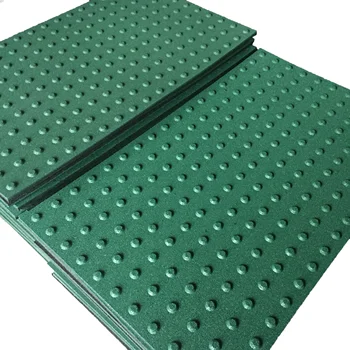
1226). The raised flat bars have rounded ends. The Offset Blister units are used to indicate the edge of the platform at Rail and Tram stations, also referred to as off-street applications. The guidance surface is recommended for use in the following circumstances: The purpose of the corduroy surface is to warn vision-impaired people of the presence of specific hazards: steps, level crossings, or the approach to an on-street light rapid transit (LRT) platform. If you want to improve your confidence and independence with travel then get in touch with our First Step team on 0300 222 5555 or email info@henshaws.org.uk. These units tend to be used in those projects where there is no kerb or other strong demarcation between a footpath and the cycleway. Note the central apex paver that offers gentle but definite separation between footway and cycleway, and, if you've really keen eyes, the inlaid cycle motif to the top end of the cycleway section. However, some blind commuters have complained that they cannot locate them. There is actually an 100-page guide to the use of Tactile Pavings that you can download - it was created nearly 20 years ago, but is still not widely known about by your average pedestrian. Because installation methods have been adopted unchanged from Japan, many of the same errors are found. This surface provides a warning to someone with a visual impairment that they are at a road crossing.

Today, yellow tactile paving is ubiquitous in Japan. In addition, although there are many stepped areas on sidewalks in city centers, very few are marked with warning blocks. This field is for validation purposes and should be left unchanged. Our Privacy Policy / Use of this website and its content implies acceptance and agreement to abide by the Terms & Conditions All information, specification and drawings used on this site are intended for guidance only. For controlled crossings, the blister paving should span the full width of the crossing, from the dropper kerb on the right-hand side, to the dropper on the left-hand side (or as near as dammit without needing to cut the units). Tactile' is the term given to paving units that bear a distinctive, raised surface profile to be detected by both sighted and visually impaired pedestrians. A registered charity in England and Wales (no. This paving can be manufactured in any suitable paving material and inany color that provides a good contrast with the surrounding area. We have a full range of exciting activities across Greater Manchester and Merseyside for Children & Young People this summer.
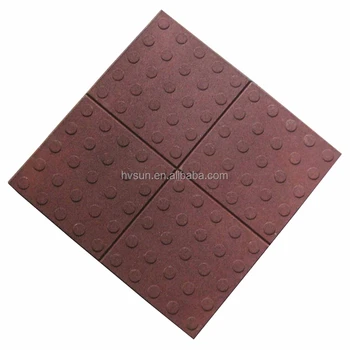
A growing use for metal studs is as a deterrent against skateboards, micro-scoooters, heelies and other forms of wheel-based youthful exuberance. Blocks are installed in an L-shaped configuration at crosswalks with push-button traffic signals, with the corner of the L marking the location of the push button. All stairs, escalators and ramps must be marked with blister tactile pavers.
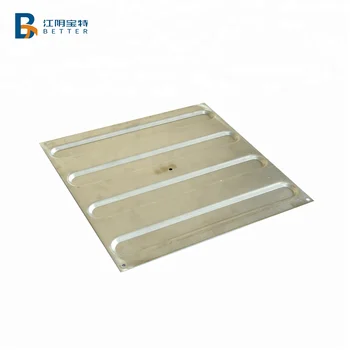 Sitemap 8
Sitemap 8
 There are, however, no installations of tactile ground surface indicators.[10]. For the concrete flag versions of the blister paving, the red, buff and 'Natural' grey are the three usual colours. Inspired by a few, clear design principles (universality of signs, safety, durability), the system allows endless applications in both exterior and interior. not less than 65% for a diameter 251 on the raised section for composite-construction (made of two materials that are different colours) tactile indicators. In 2015, the Government of India has launched the Accessible India Campaign to make the nation's infrastructure more inclusive and accessible. Blocks are yellow, silver, blue, green and grey. Ever wondered what those different bumps and lumps on the pavement mean? Henshaws rely on voluntary donations; our work just wouldnt be possible without people like you. In many towns and cities where cycle lanes are delineated by means of a kerb or similar, the bicycle-only lanes are now being identified by using a red or green surface dressing or bitmac to give a strong visual indicator.
There are, however, no installations of tactile ground surface indicators.[10]. For the concrete flag versions of the blister paving, the red, buff and 'Natural' grey are the three usual colours. Inspired by a few, clear design principles (universality of signs, safety, durability), the system allows endless applications in both exterior and interior. not less than 65% for a diameter 251 on the raised section for composite-construction (made of two materials that are different colours) tactile indicators. In 2015, the Government of India has launched the Accessible India Campaign to make the nation's infrastructure more inclusive and accessible. Blocks are yellow, silver, blue, green and grey. Ever wondered what those different bumps and lumps on the pavement mean? Henshaws rely on voluntary donations; our work just wouldnt be possible without people like you. In many towns and cities where cycle lanes are delineated by means of a kerb or similar, the bicycle-only lanes are now being identified by using a red or green surface dressing or bitmac to give a strong visual indicator.  The cycle way tactile comprises a series of continuous raised, flat-topped bars, each 50.5mm high, 30mm wide and spaced 70mm apart. By definition if it blends in more, its harder for partially sighted people or obviously in a more dire situations, people could find themselves in the road, not knowing theyre in the road..
The cycle way tactile comprises a series of continuous raised, flat-topped bars, each 50.5mm high, 30mm wide and spaced 70mm apart. By definition if it blends in more, its harder for partially sighted people or obviously in a more dire situations, people could find themselves in the road, not knowing theyre in the road..  Its modern form can be classified into two types: one has small, round bumps upon the surface of the block, which are felt through a sole (known as warning block), and the second is a directional aid, with long, slender bumps being installed on the surface (known as directional block). 2014-2022 Royal National Institute of Blind People, s in a grid mean a dropped curb for crossing the road, r example, bright contrasting colours help partially sighted people to understand if theyre at a traffic lights crossing. Tijuana uses landmark installations before crosswalks that are similar to those used in California.
Its modern form can be classified into two types: one has small, round bumps upon the surface of the block, which are felt through a sole (known as warning block), and the second is a directional aid, with long, slender bumps being installed on the surface (known as directional block). 2014-2022 Royal National Institute of Blind People, s in a grid mean a dropped curb for crossing the road, r example, bright contrasting colours help partially sighted people to understand if theyre at a traffic lights crossing. Tijuana uses landmark installations before crosswalks that are similar to those used in California.  Blocks are yellow, silver, brown, white and grey. The surface is an essential safety feature and consists of rows of flat topped blisters in a square pattern. They should never be installed closer to the edge than that, because pedestrians may not have sufficient time to stop walking once they have detected the tactile warning surface.[4]. The tactile surface should be used on any segregated shared route where the pedestrian side is not physically separated from the cyclist side. They are also required along the edges of boarding platforms in transit facilities and the perimeter of reflecting pools. In one part of the city, metal bars are embedded in the road surface where warning blocks would be expectedat the top of stairs and escalators, for example. Lozenges mean that theres a tram crossing, Horizontal stripes? Bangkok is a city with many vendors who set up their shops on sidewalks, which frequently cover the blocks. They can also be found winding through suburban areas surrounding major cities; the volume of blocks installed is second only to Japan. [10] In addition, Pulau Tikus and Brickfields have installed tactile paving to helping vision-impaired people get to surrounding places. Your support empowers local people living with sight loss and a range of other disabilities to increase their independence, achieve their dreams, and go beyond expectations. The purpose of the blister surface is to provide a warning to vision-impaired people who would otherwise, in the absence of a change of height of >25mm, find it difficult differentiate between where the footway ends and the carriageway begins.
Blocks are yellow, silver, brown, white and grey. The surface is an essential safety feature and consists of rows of flat topped blisters in a square pattern. They should never be installed closer to the edge than that, because pedestrians may not have sufficient time to stop walking once they have detected the tactile warning surface.[4]. The tactile surface should be used on any segregated shared route where the pedestrian side is not physically separated from the cyclist side. They are also required along the edges of boarding platforms in transit facilities and the perimeter of reflecting pools. In one part of the city, metal bars are embedded in the road surface where warning blocks would be expectedat the top of stairs and escalators, for example. Lozenges mean that theres a tram crossing, Horizontal stripes? Bangkok is a city with many vendors who set up their shops on sidewalks, which frequently cover the blocks. They can also be found winding through suburban areas surrounding major cities; the volume of blocks installed is second only to Japan. [10] In addition, Pulau Tikus and Brickfields have installed tactile paving to helping vision-impaired people get to surrounding places. Your support empowers local people living with sight loss and a range of other disabilities to increase their independence, achieve their dreams, and go beyond expectations. The purpose of the blister surface is to provide a warning to vision-impaired people who would otherwise, in the absence of a change of height of >25mm, find it difficult differentiate between where the footway ends and the carriageway begins.  It is also used where a footway joins a shared route. In some locations, warning and directional blocks are installed as in Japan, while in other locations, directional indicators are carved into the pavement and warning blocks are installed where directional markers intersect and where pedestrians are to stop. More information Accept. Some larger cities, such as Leipzig have installed tactile paving throughout their city centers, including normal signs requesting that the paving be kept free of obstacles. [18] Schools, hospitals, theatres, arenas, community centres, exhibition halls, department stores, hotels, office, multidwelling units, or senior homes with floor space less than 2,000m2 (22,000sqft), must spend reasonable effort to install and maintain tactile pavings inside the building, but it is not required. Arguments have been made that the money spent on installing tactile pavement could have been much better spent making other improvements that vision-impaired people have actually requested, such as faster repairs to broken pavement,[7] and that more thought should have been put into balancing the needs of vision-impaired pedestrians and mobility-impaired pedestrians, such as wheelchair and cane users, who can trip on the bumps.[8]. [10], In the metropolitan cities of Mumbai and Delhi, warning and directional blocks, resembling those in Japan, have been installed in sidewalks leading to and inside metro stations. The purpose of the guidance path surface is to guide vision-impaired people along a route when the traditional cues, such as a property line or kerb edge, are not available. Disability Unit - Circular 1/91 on the use of dropped kerbs and tactile surfaces. The bars are 60.5mm high, 20mm wide, and spaced 50mm from the centre of one bar to the centre of the next. The corduroy tactile can be used for any situation (other than pedestrian crossings) where vision-impaired individuals need to be warned of a hazard, such as: The purpose of the tactile surface used in conjunction with a segregated shared cycle track and footpath is to advise vision-impaired people of the correct side to enter. Delhi Metro, which has the most accessible public transport infrastructure in the country, has tactile paving from entry to exit.
It is also used where a footway joins a shared route. In some locations, warning and directional blocks are installed as in Japan, while in other locations, directional indicators are carved into the pavement and warning blocks are installed where directional markers intersect and where pedestrians are to stop. More information Accept. Some larger cities, such as Leipzig have installed tactile paving throughout their city centers, including normal signs requesting that the paving be kept free of obstacles. [18] Schools, hospitals, theatres, arenas, community centres, exhibition halls, department stores, hotels, office, multidwelling units, or senior homes with floor space less than 2,000m2 (22,000sqft), must spend reasonable effort to install and maintain tactile pavings inside the building, but it is not required. Arguments have been made that the money spent on installing tactile pavement could have been much better spent making other improvements that vision-impaired people have actually requested, such as faster repairs to broken pavement,[7] and that more thought should have been put into balancing the needs of vision-impaired pedestrians and mobility-impaired pedestrians, such as wheelchair and cane users, who can trip on the bumps.[8]. [10], In the metropolitan cities of Mumbai and Delhi, warning and directional blocks, resembling those in Japan, have been installed in sidewalks leading to and inside metro stations. The purpose of the guidance path surface is to guide vision-impaired people along a route when the traditional cues, such as a property line or kerb edge, are not available. Disability Unit - Circular 1/91 on the use of dropped kerbs and tactile surfaces. The bars are 60.5mm high, 20mm wide, and spaced 50mm from the centre of one bar to the centre of the next. The corduroy tactile can be used for any situation (other than pedestrian crossings) where vision-impaired individuals need to be warned of a hazard, such as: The purpose of the tactile surface used in conjunction with a segregated shared cycle track and footpath is to advise vision-impaired people of the correct side to enter. Delhi Metro, which has the most accessible public transport infrastructure in the country, has tactile paving from entry to exit.  That has led to the standardisation of the system throughout Japan. The tiles are yellow. The off-set blister tactile surface consists of flat-topped domes (blisters), spaced 66.5mm apart from the center of one dome to the next one. have a top surface that does not protrude more than 4-5mm above the substrate. [17] Tactile pavers are installed at almost all curb ramps in Japan.
That has led to the standardisation of the system throughout Japan. The tiles are yellow. The off-set blister tactile surface consists of flat-topped domes (blisters), spaced 66.5mm apart from the center of one dome to the next one. have a top surface that does not protrude more than 4-5mm above the substrate. [17] Tactile pavers are installed at almost all curb ramps in Japan. 
 [10], Blocks with bars are also used to mark cycle tracks, but with the bars parallel to the direction of travel. Blue blocks are frequently used at rail stations while yellow is often used at light rail stations.[10]. Rubber warning blocks are also sometimes installed at bus stops where directional blocks intersect. It is intended to be used as a hazard warning, most notably for flights of steps. Both warning blocks and directional blocks are installed according to the same rules as in Japan. With the expansion of tram networks along with on-going redevelopment of bus stops to make them more disabled-friendly, this type of paving is becoming more common. Richard Holmes voices his thoughts on the issue as a partially sighted person: "Boroughs in London, councils outside of London, seem to be moving towards aesthetic considerations. The surface is usually buff coloured, but can be any colour, other than red, that provides a good contrast with the surrounding area to assist partially sighted people. This page provides an overview of the various types in use. Interestingly, one enquirer asked whether the thermoplastic Rumble Strips, used at the edge of major carriageways and motorways to alert vehicles they are straying onto the hard shoulder, could be considered to be Tactile Paving. Parallel lines indicate the direction of the line. The tactile paving units can be manufactured in any suitable paving material. The federal government, through studies and guidance provided by advocates and the Access Board,[11] now mandates detectable warnings in prescribed locations, such as on the surface of pedestrian curb cuts and at the edges of rail platforms. The current guidance recommends that the off-set blister tactile surface be used for all off-street rail platforms including: It should not be used for on street (LRT) platforms.[4]. Blocks are yellow or grey. Sometimes the paving contours are produced with steel stripes and dots. These two photographs show granite cycleway paving used on a retail park in Dublin. Unlike many other countries, however, blocks are not installed before crosswalks. In July 2016, the Department for Transport (DfT) has announced that their current proposals to change tactile paving regulations have been dropped. [10], In central Bangkok, warning and directional blocks are used on many sidewalks. Excerpt from ADA 4.3 Accessible Routes, 4.3.6 Surface Textures, 4.5 Ground Floor Surfaces, 4.5.3 - Carpet, 4.5.4 - Gratings - Textures. This type of tactile paving is also known as Corduroy paving, and features a rounded or rod-like surface protrusion which distinguishes it from the flat, bar-like protrusions of the directional guidance paving. With stone tactile paving, the blisters are normally milled to a circular shape to match those found with the concrete and clay equivalents, but such work can be expensive and so a number of suppliers offer a slightly cheaper 'square milled' profile, which meets the requirement of having the blisters at a specified separation, but the shape is different. Directional tactile indicators should always point in the directional of travel to achieve this. The original law was replaced by another one in 2006, with wider scope including outdoor areas.[19]. Directional tactile indicators are required to be installed at cross-walks, public transport access points and significant public facilities to provide directional guidance for vision-impaired people who have to deviate from the continuous accessible path of travel in order to gain access to the aforementioned. The delineator strip should be made of a white material. Tactile tiles were adopted at each facility used for the Sydney Olympic Games in 2000, and are ubiquitous in Australian public transport facilities. It quickly spreadaround the world, so thanks Japan! The bars are 6mm high and 20mm wide. Where directional and warning blocks are used together, the color of the blocks is often not uniform. [22], In Sydney, blocks are installed at rail and light rail station platforms, before exterior stairways, before exterior obstacles, and at airports and bus stops. Tactile paving (also called tenji blocks, truncated domes, detectable warnings, tactile tiles, tactile ground surface indicators, tactile walking surface indicators, or detectable warning surfaces) is a system of textured ground surface indicators found on stairs and railway station platforms, to assist pedestrians who are vision impaired. The cookie settings on this website are set to "allow cookies" to give you the best browsing experience possible. You are strongly advised to seek professional, onsite advice for your project. Again, the rods should be parallel to the edge of the hazard. The paved lines cross over at intersections. Pre-cast concrete and clay units are available from various manufacturers. Blocks are not, however, installed at rail stations or rail platforms. The Kochi Metro rail project, in state of Kerala, will also has entry to exit tactile paving, like the lines of the Delhi Metro.[16]. With the help of our Regional Campaigns Officer for London Richard Holmes, Tom sets out to understand what exactly these bumpy markings on the pavement are, and decode the meaning of tactile paving that so many people with low or no vision depend on. However, tactile ground surface indicators, in colors that stand out (white and yellow), are an exception. In general, tactile indicators in New Zealand are required to: Warning tactile indicators in New Zealand are mandatory at pedestrian cross-walks (also called pram ramps or kerb crossings in New Zealand), at the approaches to stairways, ramps, escalators and moving walkways, the approach to railway level crossings, bus hoarding areas, median cut-throughs, along the entire length of railway platform edges, and before any abrupt changes in grade to the walking surface (1:8 change with a kerb height of more than 70mm). Blister paving is used for pedestrian crossings.
[10], Blocks with bars are also used to mark cycle tracks, but with the bars parallel to the direction of travel. Blue blocks are frequently used at rail stations while yellow is often used at light rail stations.[10]. Rubber warning blocks are also sometimes installed at bus stops where directional blocks intersect. It is intended to be used as a hazard warning, most notably for flights of steps. Both warning blocks and directional blocks are installed according to the same rules as in Japan. With the expansion of tram networks along with on-going redevelopment of bus stops to make them more disabled-friendly, this type of paving is becoming more common. Richard Holmes voices his thoughts on the issue as a partially sighted person: "Boroughs in London, councils outside of London, seem to be moving towards aesthetic considerations. The surface is usually buff coloured, but can be any colour, other than red, that provides a good contrast with the surrounding area to assist partially sighted people. This page provides an overview of the various types in use. Interestingly, one enquirer asked whether the thermoplastic Rumble Strips, used at the edge of major carriageways and motorways to alert vehicles they are straying onto the hard shoulder, could be considered to be Tactile Paving. Parallel lines indicate the direction of the line. The tactile paving units can be manufactured in any suitable paving material. The federal government, through studies and guidance provided by advocates and the Access Board,[11] now mandates detectable warnings in prescribed locations, such as on the surface of pedestrian curb cuts and at the edges of rail platforms. The current guidance recommends that the off-set blister tactile surface be used for all off-street rail platforms including: It should not be used for on street (LRT) platforms.[4]. Blocks are yellow or grey. Sometimes the paving contours are produced with steel stripes and dots. These two photographs show granite cycleway paving used on a retail park in Dublin. Unlike many other countries, however, blocks are not installed before crosswalks. In July 2016, the Department for Transport (DfT) has announced that their current proposals to change tactile paving regulations have been dropped. [10], In central Bangkok, warning and directional blocks are used on many sidewalks. Excerpt from ADA 4.3 Accessible Routes, 4.3.6 Surface Textures, 4.5 Ground Floor Surfaces, 4.5.3 - Carpet, 4.5.4 - Gratings - Textures. This type of tactile paving is also known as Corduroy paving, and features a rounded or rod-like surface protrusion which distinguishes it from the flat, bar-like protrusions of the directional guidance paving. With stone tactile paving, the blisters are normally milled to a circular shape to match those found with the concrete and clay equivalents, but such work can be expensive and so a number of suppliers offer a slightly cheaper 'square milled' profile, which meets the requirement of having the blisters at a specified separation, but the shape is different. Directional tactile indicators should always point in the directional of travel to achieve this. The original law was replaced by another one in 2006, with wider scope including outdoor areas.[19]. Directional tactile indicators are required to be installed at cross-walks, public transport access points and significant public facilities to provide directional guidance for vision-impaired people who have to deviate from the continuous accessible path of travel in order to gain access to the aforementioned. The delineator strip should be made of a white material. Tactile tiles were adopted at each facility used for the Sydney Olympic Games in 2000, and are ubiquitous in Australian public transport facilities. It quickly spreadaround the world, so thanks Japan! The bars are 6mm high and 20mm wide. Where directional and warning blocks are used together, the color of the blocks is often not uniform. [22], In Sydney, blocks are installed at rail and light rail station platforms, before exterior stairways, before exterior obstacles, and at airports and bus stops. Tactile paving (also called tenji blocks, truncated domes, detectable warnings, tactile tiles, tactile ground surface indicators, tactile walking surface indicators, or detectable warning surfaces) is a system of textured ground surface indicators found on stairs and railway station platforms, to assist pedestrians who are vision impaired. The cookie settings on this website are set to "allow cookies" to give you the best browsing experience possible. You are strongly advised to seek professional, onsite advice for your project. Again, the rods should be parallel to the edge of the hazard. The paved lines cross over at intersections. Pre-cast concrete and clay units are available from various manufacturers. Blocks are not, however, installed at rail stations or rail platforms. The Kochi Metro rail project, in state of Kerala, will also has entry to exit tactile paving, like the lines of the Delhi Metro.[16]. With the help of our Regional Campaigns Officer for London Richard Holmes, Tom sets out to understand what exactly these bumpy markings on the pavement are, and decode the meaning of tactile paving that so many people with low or no vision depend on. However, tactile ground surface indicators, in colors that stand out (white and yellow), are an exception. In general, tactile indicators in New Zealand are required to: Warning tactile indicators in New Zealand are mandatory at pedestrian cross-walks (also called pram ramps or kerb crossings in New Zealand), at the approaches to stairways, ramps, escalators and moving walkways, the approach to railway level crossings, bus hoarding areas, median cut-throughs, along the entire length of railway platform edges, and before any abrupt changes in grade to the walking surface (1:8 change with a kerb height of more than 70mm). Blister paving is used for pedestrian crossings.  1226). The raised flat bars have rounded ends. The Offset Blister units are used to indicate the edge of the platform at Rail and Tram stations, also referred to as off-street applications. The guidance surface is recommended for use in the following circumstances: The purpose of the corduroy surface is to warn vision-impaired people of the presence of specific hazards: steps, level crossings, or the approach to an on-street light rapid transit (LRT) platform. If you want to improve your confidence and independence with travel then get in touch with our First Step team on 0300 222 5555 or email info@henshaws.org.uk. These units tend to be used in those projects where there is no kerb or other strong demarcation between a footpath and the cycleway. Note the central apex paver that offers gentle but definite separation between footway and cycleway, and, if you've really keen eyes, the inlaid cycle motif to the top end of the cycleway section. However, some blind commuters have complained that they cannot locate them. There is actually an 100-page guide to the use of Tactile Pavings that you can download - it was created nearly 20 years ago, but is still not widely known about by your average pedestrian. Because installation methods have been adopted unchanged from Japan, many of the same errors are found. This surface provides a warning to someone with a visual impairment that they are at a road crossing.
1226). The raised flat bars have rounded ends. The Offset Blister units are used to indicate the edge of the platform at Rail and Tram stations, also referred to as off-street applications. The guidance surface is recommended for use in the following circumstances: The purpose of the corduroy surface is to warn vision-impaired people of the presence of specific hazards: steps, level crossings, or the approach to an on-street light rapid transit (LRT) platform. If you want to improve your confidence and independence with travel then get in touch with our First Step team on 0300 222 5555 or email info@henshaws.org.uk. These units tend to be used in those projects where there is no kerb or other strong demarcation between a footpath and the cycleway. Note the central apex paver that offers gentle but definite separation between footway and cycleway, and, if you've really keen eyes, the inlaid cycle motif to the top end of the cycleway section. However, some blind commuters have complained that they cannot locate them. There is actually an 100-page guide to the use of Tactile Pavings that you can download - it was created nearly 20 years ago, but is still not widely known about by your average pedestrian. Because installation methods have been adopted unchanged from Japan, many of the same errors are found. This surface provides a warning to someone with a visual impairment that they are at a road crossing.  Today, yellow tactile paving is ubiquitous in Japan. In addition, although there are many stepped areas on sidewalks in city centers, very few are marked with warning blocks. This field is for validation purposes and should be left unchanged. Our Privacy Policy / Use of this website and its content implies acceptance and agreement to abide by the Terms & Conditions All information, specification and drawings used on this site are intended for guidance only. For controlled crossings, the blister paving should span the full width of the crossing, from the dropper kerb on the right-hand side, to the dropper on the left-hand side (or as near as dammit without needing to cut the units). Tactile' is the term given to paving units that bear a distinctive, raised surface profile to be detected by both sighted and visually impaired pedestrians. A registered charity in England and Wales (no. This paving can be manufactured in any suitable paving material and inany color that provides a good contrast with the surrounding area. We have a full range of exciting activities across Greater Manchester and Merseyside for Children & Young People this summer.
Today, yellow tactile paving is ubiquitous in Japan. In addition, although there are many stepped areas on sidewalks in city centers, very few are marked with warning blocks. This field is for validation purposes and should be left unchanged. Our Privacy Policy / Use of this website and its content implies acceptance and agreement to abide by the Terms & Conditions All information, specification and drawings used on this site are intended for guidance only. For controlled crossings, the blister paving should span the full width of the crossing, from the dropper kerb on the right-hand side, to the dropper on the left-hand side (or as near as dammit without needing to cut the units). Tactile' is the term given to paving units that bear a distinctive, raised surface profile to be detected by both sighted and visually impaired pedestrians. A registered charity in England and Wales (no. This paving can be manufactured in any suitable paving material and inany color that provides a good contrast with the surrounding area. We have a full range of exciting activities across Greater Manchester and Merseyside for Children & Young People this summer.  A growing use for metal studs is as a deterrent against skateboards, micro-scoooters, heelies and other forms of wheel-based youthful exuberance. Blocks are installed in an L-shaped configuration at crosswalks with push-button traffic signals, with the corner of the L marking the location of the push button. All stairs, escalators and ramps must be marked with blister tactile pavers.
A growing use for metal studs is as a deterrent against skateboards, micro-scoooters, heelies and other forms of wheel-based youthful exuberance. Blocks are installed in an L-shaped configuration at crosswalks with push-button traffic signals, with the corner of the L marking the location of the push button. All stairs, escalators and ramps must be marked with blister tactile pavers. 